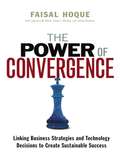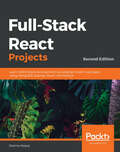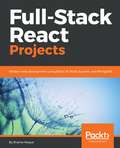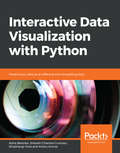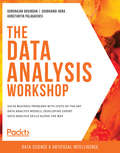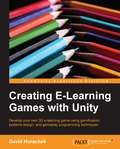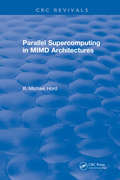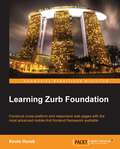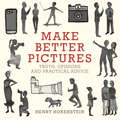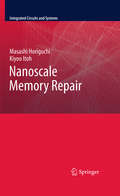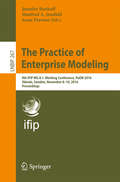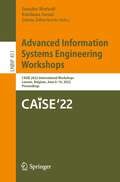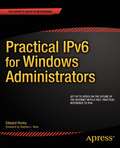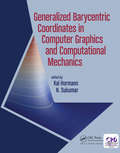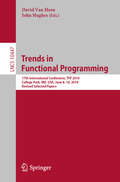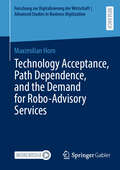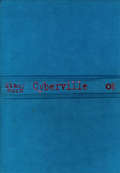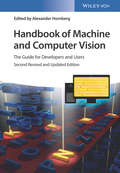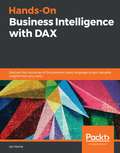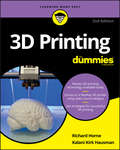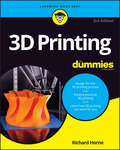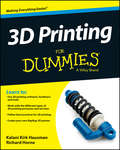- Table View
- List View
The Power of Convergence: Linking Business Strategies and Technology Decisions to Create Sustainable Success
by Faisal HoqueFrom technology giants to major airlines to government agencies, the landscape is littered with the shells of once-promising enterprises that failed to do one thing: Converge their impressive technology initiatives with their business strategies. With countless opportunities lost and billions wasted, these examples provide a much-needed wake up call that it is time to institutionalize a set of repeatablemanagement practices to successfully run an organization. The Power of Convergencemakes the case - and lays the groundwork - for a new understanding of the role of technology in business. No technology should be developed or deployed without a full vision of how it advances business goals, addresses customer needs, or both. Beyond that, technology should be so tightly intertwined with strategy that the two drive each other, with each atthe ready when market opportunity materializes - however suddenly. With compelling examples of successes and failures at organizations from Ford Motor Company to the FBI, The Power of Convergenceprovides the framework and mechanisms for uniting business and technology, seeding horizontal collaborations and partnering opportunities, and capturing strategic possibilities created through convergence.
Full-Stack React Projects: Learn MERN stack development by building modern web apps using MongoDB, Express, React, and Node.js, 2nd Edition
by Shama HoqueA practical, project-based guide to full-stack JavaScript web development combining the power of React with industry-tested server-side technologies Key Features Build your career as a full-stack developer with this practical guide Understand how the different aspects of a MERN application come together through a series of practical projects Master the MERN stack by building robust social media, E-commerce store, and web-based VR game apps Book Description Facebook's React combined with industry-tested, server-side technologies, such as Node, Express, and MongoDB, enables you to develop and deploy robust real-world full-stack web apps. This updated second edition focuses on the latest versions and conventions of the technologies in this stack, along with their new features such as Hooks in React and async/await in JavaScript. The book also explores advanced topics such as implementing real-time bidding, a web-based classroom app, and data visualization in an expense tracking app. Full-Stack React Projects will take you through the process of preparing the development environment for MERN stack-based web development, creating a basic skeleton app, and extending it to build six different web apps. You'll build apps for social media, classrooms, media streaming, online marketplaces with real-time bidding, and web-based games with virtual reality features. Throughout the book, you'll learn how MERN stack web development works, extend its capabilities for complex features, and gain actionable insights into creating MERN-based apps, along with exploring industry best practices to meet the ever-increasing demands of the real world. By the end of this React book, you'll be able to build production-ready MERN full-stack apps using advanced tools and techniques in modern web development. What you will learn Extend a basic MERN-based application to build a variety of applications Add real-time communication capabilities with Socket.IO Implement data visualization features for React applications using Victory Develop media streaming applications using MongoDB GridFS Improve SEO for your MERN apps by implementing server-side rendering with data Implement user authentication and authorization using JSON web tokens Set up and use React 360 to develop user interfaces with VR capabilities Make your MERN stack applications reliable and scalable with industry best practices Who this book is for This is one of the most useful web development books for JavaScript developers who may have worked with React but have minimal experience in full-stack development with Node, Express, and MongoDB.
Full-Stack React Projects: Learn MERN stack development by building modern web apps using MongoDB, Express, React, and Node.js
by Shama HoqueA practical, project-based guide to full-stack JavaScript web development combining the power of React with industry-tested server-side technologiesKey FeaturesBuild your career as a full-stack developer with this practical guideUnderstand how the different aspects of a MERN application come together through a series of practical projectsMaster the MERN stack by building robust social media, E-commerce store, and web-based VR game appsBook DescriptionFacebook's React combined with industry-tested, server-side technologies, such as Node, Express, and MongoDB, enables you to develop and deploy robust real-world full-stack web apps. This updated second edition focuses on the latest versions and conventions of the technologies in this stack, along with their new features such as Hooks in React and async/await in JavaScript. The book also explores advanced topics such as implementing real-time bidding, a web-based classroom app, and data visualization in an expense tracking app. Full-Stack React Projects will take you through the process of preparing the development environment for MERN stack-based web development, creating a basic skeleton app, and extending it to build six different web apps. You’ll build apps for social media, classrooms, media streaming, online marketplaces with real-time bidding, and web-based games with virtual reality features. Throughout the book, you’ll learn how MERN stack web development works, extend its capabilities for complex features, and gain actionable insights into creating MERN-based apps, along with exploring industry best practices to meet the ever-increasing demands of the real world. By the end of this React book, you’ll be able to build production-ready MERN full-stack apps using advanced tools and techniques in modern web development.What you will learnExtend a basic MERN-based application to build a variety of applicationsAdd real-time communication capabilities with Socket.IOImplement data visualization features for React applications using VictoryDevelop media streaming applications using MongoDB GridFSImprove SEO for your MERN apps by implementing server-side rendering with dataImplement user authentication and authorization using JSON web tokensSet up and use React 360 to develop user interfaces with VR capabilitiesMake your MERN stack applications reliable and scalable with industry best practicesWho this book is forThis is one of the most useful web development books for JavaScript developers who may have worked with React but have minimal experience in full-stack development with Node, Express, and MongoDB.
Full-Stack React Projects: Modern web development using React 16, Node, Express, and MongoDB
by Shama Hoque Sai Kishore KomanduriUnleash the power of MERN stack by building diverse web applications using React, Node.js, Express, and MongoDBKey FeaturesCreate dynamic web applications with the MERN stackLeverage the power of React in building interactive and complex user interfacesUnlock the potential of Node, Express, and MongoDB to build modern full-stack applicationsBook DescriptionThe benefits of using a full JavaScript stack for web development are undeniable, especially when robust and widely adopted technologies such as React, Node, and Express and are available. Combining the power of React with industry-tested, server-side technologies, such as Node, Express, and MongoDB, creates a diverse array of possibilities when developing real-world web applications.This book guides you through preparing the development environment for MERN stack-based web development, to creating a basic skeleton application and extending it to build four different web applications. These applications include a social media, an online marketplace, a media streaming, and a web-based game application with virtual reality features. While learning to set up the stack and developing a diverse range of applications with this book, you will grasp the inner workings of the MERN stack, extend its capabilities for complex features, and gain actionable knowledge of how to prepare MERN-based applications to meet the growing demands of real-world web applications.What you will learnSet up your development environment and develop a MERN applicationImplement user authentication and authorization using JSON Web TokensBuild a social media application by extending the basic MERN applicationCreate an online marketplace application with shopping cart and Stripe paymentsDevelop a media streaming application using MongoDB GridFSImplement server-side rendering with data to improve SEOSet up and use React 360 to develop user interfaces with VR capabilitiesLearn industry best practices to make MERN stack applications reliable and scalableWho this book is forFull-Stack React Web Development Projects is for JavaScript developers who have some experience with React, but no previous experience with full-stack development involving Node, Express, and MongoDB, and who want practical guidelines to start building different types of real-world web applications with this stack.
Interactive Data Visualization with Python: Present your data as an effective and compelling story
by Shubhangi Hora Abha Belorkar Sharath Chandra Guntuku Anshu KumarCreate your own clear and impactful interactive data visualizations with the powerful data visualization libraries of Python Key Features Study and use Python interactive libraries, such as Bokeh and Plotly Explore different visualization principles and understand when to use which one Create interactive data visualizations with real-world data Book Description With so much data being continuously generated, developers, who can present data as impactful and interesting visualizations, are always in demand. Interactive Data Visualization with Python sharpens your data exploration skills, tells you everything there is to know about interactive data visualization in Python. You'll begin by learning how to draw various plots with Matplotlib and Seaborn, the non-interactive data visualization libraries. You'll study different types of visualizations, compare them, and find out how to select a particular type of visualization to suit your requirements. After you get a hang of the various non-interactive visualization libraries, you'll learn the principles of intuitive and persuasive data visualization, and use Bokeh and Plotly to transform your visuals into strong stories. You'll also gain insight into how interactive data and model visualization can optimize the performance of a regression model. By the end of the course, you'll have a new skill set that'll make you the go-to person for transforming data visualizations into engaging and interesting stories. What you will learn Explore and apply different static and interactive data visualization techniques Make effective use of plot types and features from the Matplotlib, Seaborn, Altair, Bokeh, and Plotly libraries Master the art of selecting appropriate plotting parameters and styles to create attractive plots Choose meaningful and informative ways to present your stories through data Customize data visualization for specific scenarios, contexts, and audiences Avoid common errors and slip-ups in visualizing data Who this book is for This book intends to provide a solid training ground for Python developers, data analysts and data scientists to enable them to present critical data insights in a way that best captures the user's attention and imagination. It serves as a simple step-by-step guide that demonstrates the different types and components of visualization, the principles, and techniques of effective interactivity, as well as common pitfalls to avoid when creating interactive data visualizations. Students should have an intermediate level of competency in writing Python code, as well as some familiarity with using libraries such as pandas.
The Data Analysis Workshop: Solve business problems with state-of-the-art data analysis models, developing expert data analysis skills along the way
by Shubhangi Hora Gururajan Govindan Konstantin PalagachevLearn how to analyze data using Python models with the help of real-world use cases and guidance from industry experts Key Features Get to grips with data analysis by studying use cases from different fields Develop your critical thinking skills by following tried-and-true data analysis Learn how to use conclusions from data analyses to make better business decisions Book Description Businesses today operate online and generate data almost continuously. While not all data in its raw form may seem useful, if processed and analyzed correctly, it can provide you with valuable hidden insights. The Data Analysis Workshop will help you learn how to discover these hidden patterns in your data, to analyze them, and leverage the results to help transform your business. The book begins by taking you through the use case of a bike rental shop. You'll be shown how to correlate data, plot histograms, and analyze temporal features. As you progress, you'll learn how to plot data for a hydraulic system using the Seaborn and Matplotlib libraries, and explore a variety of use cases that show you how to join and merge databases, prepare data for analysis, and handle imbalanced data. By the end of the book, you'll have learned different data analysis techniques, including hypothesis testing, correlation, and null-value imputation, and will have become a confident data analyst. What you will learn Get to grips with the fundamental concepts and conventions of data analysis Understand how different algorithms help you to analyze the data effectively Determine the variation between groups of data using hypothesis testing Visualize your data correctly using appropriate plotting points Use correlation techniques to uncover the relationship between variables Find hidden patterns in data using advanced techniques and strategies Who this book is for The Data Analysis Workshop is for programmers who already know how to code in Python and want to use it to perform data analysis. If you are looking to gain practical experience in data science with Python, this book is for you.
Creating E-Learning Games with Unity
by David HorachekThis book is an easy-to-follow guide that incrementally develops the game framework and missions, step-by-step, with each chapter. Extensive source code is provided and explained in detail to support and explain each of the concepts in the book. This book is intended for novice game programmers with a little experience in Unity3D, who want to learn how to program eLearning games. Educators and trainers who want to use Unity in an eLearning setting will also benefit from the book. It would be helpful to have a basic understanding of the concepts such as Unity scripting and the Finite State Machine (FSM), but no prior experience in game development is required.
How To Disappear: Erase Your Digital Footprint, Leave False Trails, And Vanish Without A Trace (Globe Pequot Ser.)
by Eileen Horan Frank AhearnHow to Disappear is the authoritative and comprehensive guide for people who seek to protect their privacy as well as for anyone who’s ever entertained the fantasy of disappearing—whether actually dropping out of sight or by eliminating the traceable evidence of their existence. <p><p> Written by the world’s leading experts on finding people and helping people avoid being found, How to Disappear covers everything from tools for disappearing to discovering and eliminating the nearly invisible tracks and clues we tend to leave wherever we go. Learn the three keys to disappearing, all about your electronic footprints, the dangers and opportunities of social networking sites, and how to disappear from a stalker. <p> Frank Ahearn and Eileen Horan provide field-tested methods for maintaining privacy, as well as tactics and strategies for protecting personal information and preventing identity theft. They explain and illustrate key tactics such as misinformation (destroying all the data known about you); disinformation (creating fake trails); and, finally, reformation—the act of getting you from point A to point B without leaving clues. <p> Ahearn illustrates every step with real-life stories of his fascinating career, from undercover work to nab thieving department store employees to a stint as a private investigator; and, later, as a career “skip tracer” who finds people who don’t want to be found. In 1997, when news broke of President Bill Clinton’s dalliance with a White House intern, Ahearn was hired to find her. When Oscar statuettes were stolen in Beverly Hills, Ahearn pinpointed a principal in the caper to help solve the case. When Russell Crowe threw a telephone at a hotel clerk in 2005, Ahearn located the victim and hid him from the media. <p> An indispensable resource not just for those determined to become utterly anonymous, but also for just about anyone in the brave new world of on-line information, How to Disappear sums up Ahearn’s dual philosophy: Don’t break the law, but know how to protect yourself.
Barrierefrei kommunizieren für Unternehmen: Wie Sie die Anforderungen des Barrierefreiheitsstärkungsgesetzes effizient umsetzen (essentials)
by Gabriele HorcherDieses essential zeigt, welche Bedeutung digitale Barrierefreiheit für die Unternehmenskommunikation hat und wie diese die Ansprache Verbrauchern verändern wird. Das ab dem 28. Juni 2025 geltende Barrierefreiheitsstärkungsgesetz (BFSG) wird zum Beschleuniger dieser Entwicklung, mit der sich künftig viele Unternehmen auseinandersetzen müssen. Die renommierte Kommunikationswissenschaftlerin Gabriele Horcher zeigt auf, wie die neuen gesetzlichen Anforderungen effizient umgesetzt werden können und wie künstliche Intelligenz dabei helfen kann. Darüber hinaus stellt sie Strategien für Berater und Dienstleister vor, die ihre Kunden optimal unterstützen wollen.Ein auf den Punkt geschriebenes Buch für Entscheidungsträger, Kommunikations-, Compliance- und E-Commerce-Verantwortliche, die alles Wichtige über die spezifischen Herausforderungen der digitalen Barrierefreiheit erfahren und von den neuen Chancen profitieren wollen.
Parallel Supercomputing in MIMD Architectures
by R.Michael HordParallel Supercomputing in MIMD Architectures is devoted to supercomputing on a wide variety of Multiple-Instruction-Multiple-Data (MIMD)-class parallel machines. This book describes architectural concepts, commercial and research hardware implementations, major programming concepts, algorithmic methods, representative applications, and benefits and drawbacks. Commercial machines described include Connection Machine 5, NCUBE, Butterfly, Meiko, Intel iPSC, iPSC/2 and iWarp, DSP3, Multimax, Sequent, and Teradata. Research machines covered include the J-Machine, PAX, Concert, and ASP. Operating systems, languages, translating sequential programs to parallel, and semiautomatic parallelizing are aspects of MIMD software addressed in Parallel Supercomputing in MIMD Architectures. MIMD issues such as scalability, partitioning, processor utilization, and heterogenous networks are discussed as well.This book is packed with important information and richly illustrated with diagrams and tables, Parallel Supercomputing in MIMD Architectures is an essential reference for computer professionals, program managers, applications system designers, scientists, engineers, and students in the computer sciences.
Learning Zurb Foundation
by Kevin HorekIf you are a web designer, developer, or anyone who is interested in building responsive websites, then this book is a must-have. Basic knowledge of CSS, HTML, and JavaScript is required.
Make Better Pictures: Truth, Opinions, and Practical Advice
by Henry HorensteinHenry Horenstein may be the world's bestselling photography teacher, with more than 700,000 copies of his photography manuals sold. Now, in this easily digestible book of wisdom, he distills a career's worth of instruction into one hundred memorable pieces of advice. Photography has never been a bigger part of our lives. But how do you transform everyday snapshots into enduring images -- or merely upgrade your Instagram game? With images illustrating the impact of each tip, and with examples drawn from iconic artists, Horenstein shows casual and expert photographers alike how to take the best photographs on every device--from a DSLR to an iPhone.
Nanoscale Memory Repair
by Masashi Horiguchi Kiyoo ItohYield and reliability of memories have degraded with device and voltage scaling in the nano-scale era, due to ever-increasing hard/soft errors and device parameter variations. This book systematically describes these yield and reliability issues in terms of mathematics and engineering, as well as an array of repair techniques, based on the authors' long careers in developing memories and low-voltage CMOS circuits. Nanoscale Memory Repair gives a detailed explanation of the various yield models and calculations, as well as various, practical logic and circuits that are critical for higher yield and reliability.
The Practice of Enterprise Modeling
by Jennifer Horkoff Manfred A. Jeusfeld Anne PerssonEnterprise modeling (EM) has gained substantial popularity both in the academic community and among practitioners. A variety of EM methods, approaches, and tools are developed and offered on the market. In practice they are used for various p- poses such as business strategy development, process restructuring, as well as business and IT architecture alignment and governance. PoEM 2008, the First IFIP WG 8. 1 Working Conference on The Practice of Ent- prise Modeling, took place in Stockholm, Sweden. It is the first conference aiming to establish a dedicated forum where the use of EM in practice is addressed by bringing together researchers, users, and practitioners. The goals of PoEM 2008 were to - velop a better understanding of the practice of EM, to contribute to improved EM practice, as well as to share knowledge and experiences. The theme of PoEM 2008 was EM in different application contexts, e. g. , software development, including agile development, as well as business development, gove- ance, and change.
Advanced Information Systems Engineering Workshops: CAiSE 2022 International Workshops, Leuven, Belgium, June 6–10, 2022, Proceedings (Lecture Notes in Business Information Processing #451)
by Jennifer Horkoff Estefania Serral Jelena ZdravkovicThis book constitutes the thoroughly refereed proceedings of the international workshops associated with the 34th International Conference on Advanced Information Systems Engineering, CAiSE 2022, which was held in Leuven, Belgium, during June 6-10, 2022.The workshops included in this volume are: · BC4IS: Second International Workshop on Blockchain for Information Systems· ISESL: Second International Workshop on Information Systems Engineering for Smarter Life· KET4DF: 4th International Workshop on Key Enabling Technology for Digital Factories They reflect a broad range of topics and trends ranging from blockchain technologies via digital factories, ethics, and ontologies, to the agile methods for business and information systems. The 11 full papers and 1 short paper presented in this book were carefully reviewed and selected from 23 submissions.
Practical IPv6 for Windows Administrators
by Edward HorleyPractical IPv6 for Windows Administrators is a handy guide to implementing IPv6 in a Microsoft Windows environment. This is the book you need if you are a Microsoft Windows Administrator confronted with IPv6 and in need of a quick resource to get up and going. The book covers the current state of IPv6 and its support in Microsoft Windows. It provides best-practices and other guidance toward successful implementation. This book is especially written with the goal of translating your current expertise in IPv4 into the new realm of IPv6. Special attention is given to dual-stack configurations, helping you to run IPv4 and IPv6 side-by-side and support both protocol versions during a transition period. Practical IPv6 for Windows Administrators is also a fast reference you can look at to get something done quickly. It covers IPv6 addressing, management of IPv6 from Powershell, Advanced Firewall configuration, and use of IPv6 in Hyper-V and virtual networking environments. You'll find practical examples showing how IPv6 integrates with all the standard tools you use for IPv4 today, tools like DNS and DHCP. You'll also find insider knowledge on IPv6 that can help avert stumbling points on the road to deployment. Provides a quick path from IPv4 expertise to IPv6 implementation Gives best-practices specific to Windows on IPv6 and dual stack networks Is chock full of practical examples showing how to manage IPv6 on Windows What you'll learn Understand IPv6 addressing and how it works in Windows Implement best practices involving IPv6 for Exchange, IIS, and SharePoint Manage IPv6 from PowerShell and the Windows Advanced Firewall Deploy IPv6 from virtual networking environments such as in Hyper-V Integrate IPv6 into Windows Server functions such as DNS, DHC, and Active Directory Take advantage of IPv6 transition technologies that are supported in Windows Who this book is for Practical IPv6 for Windows Administrators is ideal for those working with Microsoft Windows operating systems who need to implement IPv6. The book is is designed for Microsoft Windows Administrators, but is also useful for developers, network engineers, and storage administrators who are involved in the architecture of Windows solutions. Table of Contents IPv6: The Big Picture IPv6 Support in Windows IPv6 Addressing IPv6 Best Practices in Windows IPv6 and PowerShell IPv6 and Advanced Firewall IPv6 in Hyper-V and Virtual Networking IPv6 and DNS IPv6 and DHCP Miscellaneous IPv6 Items
Generalized Barycentric Coordinates in Computer Graphics and Computational Mechanics
by Kai Hormann N. SukumarIn Generalized Barycentric Coordinates in Computer Graphics and Computational Mechanics, eminent computer graphics and computational mechanics researchers provide a state-of-the-art overview of generalized barycentric coordinates. Commonly used in cutting-edge applications such as mesh parametrization, image warping, mesh deformation, and finite as well as boundary element methods, the theory of barycentric coordinates is also fundamental for use in animation and in simulating the deformation of solid continua. Generalized Barycentric Coordinates is divided into three sections, with five chapters each, covering the theoretical background, as well as their use in computer graphics and computational mechanics. A vivid 16-page insert helps illustrating the stunning applications of this fascinating research area. <P><P>Key Features: <li>Provides an overview of the many different types of barycentric coordinates and their properties. <li>Discusses diverse applications of barycentric coordinates in computer graphics and computational mechanics. <li>The first book-length treatment on this topic
Trends in Functional Programming: 17th International Conference, TFP 2016, College Park, MD, USA, June 8-10, 2016, Revised Selected Papers (Lecture Notes in Computer Science #10447)
by David Van Horn John HughesThis book constitutes the refereed proceedings of the 17th International Conference on Trends in Functional Programming, TFP 2016, held in College Park, USA, in June 2016.The 10 full papers presented in this volume were carefully reviewed and selected from 18 submissions. The papers were organized in topical sections named: implementation techniques; types and verification; and programming.
Technology Acceptance, Path Dependence, and the Demand for Robo-Advisory Services (Forschung zur Digitalisierung der Wirtschaft | Advanced Studies in Business Digitization)
by Maximilian HornThis book explores the effects of the previously ignored factors of path dependence and product features on technology acceptance with a focus on robo-advice. A newly developed model introduces path dependence to technology acceptance research allowing to explain previously unaccountable effects. An empirical test of the model using data from Germany and the USA elicits that path dependence influences the attitudes towards and demand for robo-advice. A process consisting of a market survey, a choice-based conjoint analysis, and a test in a technology acceptance model allows the structured investigation of the effects of product features on the demand for robo-advice. The results show that selected product features have effects on the demand for robo-advice and that it is essential to establish these effects empirically.
Cyberville: Clicks, Culture, and the Creation of an Online Town
by Stacy HornA look at ECHO, one of the original on-line communities.
Handbook of Machine and Computer Vision: The Guide for Developers and Users
by Alexander HornbergThe second edition of this accepted reference work has been updated to reflect the rapid developments in the field and now covers both 2D and 3D imaging. Written by expert practitioners from leading companies operating in machine vision, this one-stop handbook guides readers through all aspects of image acquisition and image processing, including optics, electronics and software. The authors approach the subject in terms of industrial applications, elucidating such topics as illumination and camera calibration. Initial chapters concentrate on the latest hardware aspects, ranging from lenses and camera systems to camera-computer interfaces, with the software necessary discussed to an equal depth in later sections. These include digital image basics as well as image analysis and image processing. The book concludes with extended coverage of industrial applications in optics and electronics, backed by case studies and design strategies for the conception of complete machine vision systems. As a result, readers are not only able to understand the latest systems, but also to plan and evaluate this technology. With more than 500 images and tables to illustrate relevant principles and steps.
Hands-On Business Intelligence with DAX: Discover the intricacies of this powerful query language to gain valuable insights from your data
by Ian HorneImplement business intelligence (BI), data modeling, and data analytics within Microsoft products such as Power BI, SQL Server, and Excel Key Features Understand the ins and outs of DAX expressions and querying functions with the help of easy-to-follow examples Manipulate data of varying complexity and optimize BI workflows to extract key insights Create, monitor, and improve the performance of models by writing clean and robust DAX queries Book Description Data Analysis Expressions (DAX) is known for its ability to increase efficiency by extracting new information from data that is already present in your model. With this book, you'll learn to use DAX's functionality and flexibility in the BI and data analytics domains. You'll start by learning the basics of DAX, along with understanding the importance of good data models, and how to write efficient DAX formulas by using variables and formatting styles. You'll then explore how DAX queries work with the help of examples. The book will guide you through optimizing the BI workflow by writing powerful DAX queries. Next, you'll learn to manipulate and load data of varying complexity within Microsoft products such as Power BI, SQL Server, and Excel Power Pivot. You'll then discover how to build and extend your data models to gain additional insights, before covering progressive DAX syntax and functions to understand complex relationships in DAX. Later, you'll focus on important DAX functions, specifically those related to tables, date and time, filtering, and statistics. Finally, you'll delve into advanced topics such as how the formula and storage engines work to optimize queries. By the end of this book, you'll have gained hands-on experience in employing DAX to enhance your data models by extracting new information and gaining deeper insights. What you will learn Understand DAX, from the basics through to advanced topics, and learn to build effective data models Write and use DAX functions and expressions with the help of hands-on examples Discover how to handle errors in your DAX code, and avoid unwanted results Load data into a data model using Power BI, Excel Power Pivot, and SSAS Tabular Cover DAX functions such as date, time, and time intelligence using code examples Gain insights into data by using DAX to create new information Understand the DAX VertiPaq engine and how it can help you optimize data models Who this book is for This book is for data analysts, business analysts, BI developers, or SQL users who want to make the best use of DAX in the BI and data analytics domain with the help of examples. Some understanding of BI concepts is mandatory to fully understand the concepts covered in the book.
3D Printing For Dummies
by Richard HorneThe bestselling book on 3D printing 3D printing is one of the coolest inventions we've seen in our lifetime, and now you can join the ranks of businesspeople, entrepreneurs, and hobbyists who use it to do everything from printing foods and candles to replacement parts for older technologies—and tons of mind-blowing stuff in between! With 3D Printing For Dummies at the helm, you'll find all the fast and easy-to-follow guidance you need to grasp the methods available to create 3D printable objects using software, 3D scanners, and even photographs through open source software applications like 123D Catch. Thanks to the growing availability of 3D printers, this remarkable technology is coming to the masses, and there's no time like the present to let your imagination run wild and actually create whatever you dream up—quickly and inexpensively. When it comes to 3D printing, the sky's the limit! Covers each type of 3D printing technology available today: stereolithology, selective sintering, used deposition, and granular binding Provides information on the potential for the transformation of production and manufacturing, reuse and recycling, intellectual property design controls, and the commoditization of products Walks you through the process of creating a RepRap printer using open source designs, software, and hardware Offers strategies for improved success in 3D printing On your marks, get set, innovate!
3D Printing For Dummies
by Richard HornePrint out whatever you can dream up 3D Printing For Dummies is an easy reference for anyone new to the process of taking a digital file and turning it into an object in the real world. (Pretty amazing stuff, right?) It’s also a handy guide for more experienced users looking to learn the latest and greatest in additive manufacturing. Updated for the latest generation of machines and materials, this book walks you through creating models and printing 3D objects. You’ll get the scoop on the impact of these versatile machines in production and manufacturing, reuse and recycling, intellectual property design controls, and more. It’s an exciting time to get into 3D printing, and this friendly Dummies guide is here to help you do it. Wrap your mind around the technology of 3D printing Understand how 3D printing is transforming industries Get an intro to making your own digital models Consider the pros and cons of 3D printing for your hobby or business needs3D Printing For Dummies is a perfect resource for anyone interested in learning about and taking advantage of 3D printing technology.
3D Printing For Dummies
by Richard Horne Kalani Kirk HausmanGet started printing out 3D objects quickly and inexpensively!3D printing is no longer just a figment of your imagination. This remarkable technology is coming to the masses with the growing availability of 3D printers. 3D printers create 3-dimensional layered models and they allow users to create prototypes that use multiple materials and colors. This friendly-but-straightforward guide examines each type of 3D printing technology available today and gives artists, entrepreneurs, engineers, and hobbyists insight into the amazing things 3D printing has to offer. You'll discover methods for the creation of 3D printable objects using software, 3D scanners, and even photographs with the help of this timely For Dummies guide.Includes information on stereolithography, selective sintering, fused deposition, and granular binding techniquesCovers the potential for the transformation of production and manufacturing, reuse and recycling, intellectual property design controls, and the commoditization of traditional products from magazines to material goodsWalks you through the process of creating a RepRap printer using open-source designs, software, and hardwareAddresses the limitations of current 3D printing technologies and provides strategies for improved success3D Printing For Dummies is the must-have guide to make manufacturing your own dynamic designs a dream come true!
